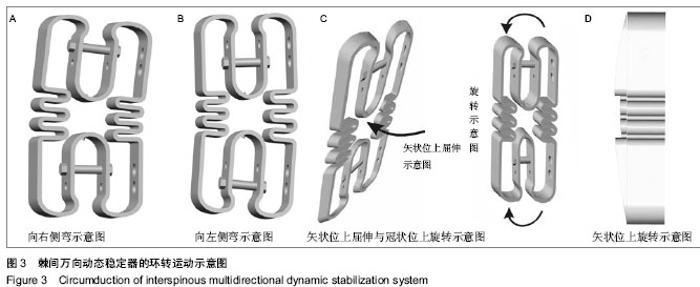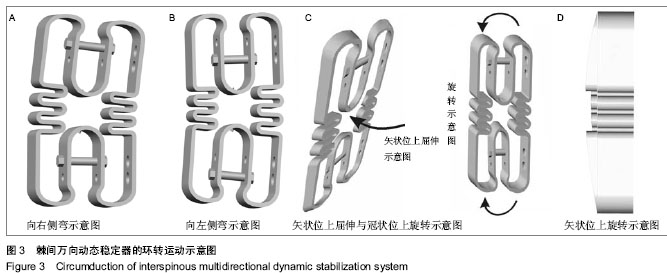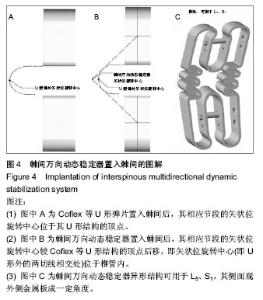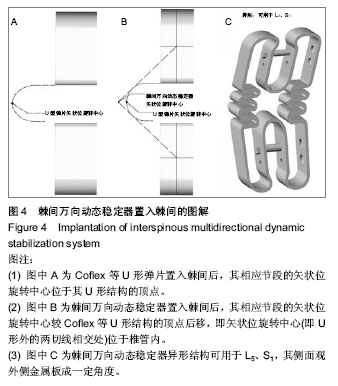Chinese Journal of Tissue Engineering Research ›› 2014, Vol. 18 ›› Issue (4): 619-624.doi: 10.3969/j.issn.2095-4344.2014.04.022
Previous Articles Next Articles
Theoretical verification of a new spinal dynamic stabilization system
Li Zhao-wen
- Department of Orthopedic Diseases, Gongan County Hospital of Traditional Chinese Medicine, Jingzhou 434300, Hubei Province, China
-
Revised:2013-10-27Online:2014-01-22Published:2014-01-22 -
About author:Li Zhao-wen, Associate chief physician, Department of Orthopedic Diseases, Gongan County Hospital of Traditional Chinese Medicine, Jingzhou 434300, Hubei Province, China
CLC Number:
Cite this article
Li Zhao-wen. Theoretical verification of a new spinal dynamic stabilization system[J]. Chinese Journal of Tissue Engineering Research, 2014, 18(4): 619-624.
share this article

Coflex系统是带有U形结构的脊椎棘突弹性内固定器,虽能在棘间实现弹性撑开,并能让手术节段脊柱保留在矢状位上屈伸,但该类固定器却不能实现手术节段侧弯与旋转等运动[19]。而正常情况下人体的腰椎需要进行的活动有前后方向的前屈、后伸,左右方向的侧屈,冠状位与矢状位上的旋转,以及上述各方向之间同时作用所形成的环转运动。本发明所述的棘间万向动态稳定器由于采用内、外双层弹性金属板制成,其内金属板固定于棘突根部(棘突与椎板移行处,棘突此处骨质最牢),U形变形结构3则位于棘间和棘突的两侧,因而有较长的形变范围;通过外层金属板1本身的弹性和中部的U形变形结构3及两端的内外层空心弧形部份的弹性共同作用与相互补充,实现棘间弹性承载、脊柱前后方向的前屈、后伸,左右方向的侧屈(图3A,B),冠状位与矢状位上的旋转(图3C,D),以及上述各方向之间同时作用所形成的环转运动。 Coflex系统的U形架还要求其总高度一般会大于等于15 mm(小于此高度很难制作),又因贴近硬膜安装时可能导致硬膜撕裂[20-21],故安装时尽量为固定器远离硬膜,通常需让固定器退后3-5 mm以上安放,这无疑又会要求棘突后缘高度在上述1.5 cm基础上再增加3-5 mm,达到1.8-2.0 cm以上,而这一尺寸仅为部分有一定身高的人体棘突高度[22]。由于其“U”形部分的长度往往与棘突后缘的高度相当,故其开口处的基部尾端往往会接触或顶住棘上韧带,出现屈伸活动时基部尾端与棘上韧带磨擦导致炎性反应致无菌性渗液或假体移位、棘上韧带断裂等情况,故其在安装时一般要移除棘上韧带;当棘突高度小于1.8-2.0 cm时则不适合安装,因此对棘突矮小者不能应用。本发明所述的棘间万向动态稳定器一般板的高度为 4-6 mm及安装时远离硬膜3 mm即可,故可用于棘突高度大于9 mm的病例,而一般人体棘突高度大于12 mm,故本发明不受棘突过矮的限制;由于其高度明显小于棘突高度,不会刺激棘上韧带,故可保留棘上韧带。 Coflex系统的U形架与棘突相贴的基部与侧翼成直角相连,而一般人体棘突的周径为根部(与椎板移形处)明显小于棘突中部(棘间韧带附着处)、棘突中部的周径又会明显小于棘突后部(相当于棘上韧带附着处),且棘突的中后部呈不规则的向四周膨隆状,并非方方正正;且正常人体棘突的上下缘并非呈直角过渡,而为类“U”形过渡,故Coflex系统安装时须修整并切除较多的棘突骨质;且其基部与侧翼不能与棘突表面骨质充分贴附,应力易集中造成固定器在此基部与侧翼连接处断裂或出现棘突骨折或术后假体松动[23-24]。本发明安于棘突根部,其内层金属板与棘突相贴处呈类“U”形过渡,与棘突骨质贴附良好,其应力分散。 Coflex系统屈伸的旋转中心位于“U”形的顶部(图4),即位于椎管外(椎管的后方),而正常人体脊柱的旋转中心位于椎管内(椎管的中后部),故其不符合人体脊柱正常的生理活动轴。而本发明其矢状位上的旋转中心位于椎管内(椎管的中后部) (图4);可与人体脊柱正常的生理活动轴重合。 "


Coflex系统安装后可能向后脱出或引起棘突骨折[25];本发明所述的棘间万向动态稳定器其内层金属板上的多孔设计以适应棘突的不规则外形,让术者选择骨质较厚的地方进行一孔或多孔固定,以提高固定的可靠性,还可不通过棘突上钻孔而直接将固紧螺栓5或固紧插销9或弹性绳索跨过棘突而通过上、下相邻的棘间隙紧贴手术节段棘突的上或下缘固定,并尽量通过上述固紧装置使内层金属板2与棘突贴附,以使棘突被内层金属板2夹紧后充分受力而不至于让应力集中于固紧螺栓5或固紧插销9与棘突相连处。根据力学原理,当棘突受到扭转等爆发力时,同样大小的外力作用于棘突根部时力臂最短,作用于棘突中部则次之,作用于棘突后部则力臂最长;而本稳定器系固定于棘突根部,从而在外力作用下不易出现棘突折断。 有研究认为,在L5/S1棘突间置入Coflex装置后,由于腰骶椎的特殊结构,可能导致Coflex假体固定不稳定,不适宜在该节段应用[18]。由于形状不匹配等原因,Coflex系统在置入L5,S1或腰椎前凸角较大的间隙时,其安装困难,或安装后易脱落[23-24]。本发明所述的棘间万向动态稳定器其外层金属板1的中部制作成U形变形结构从侧面观不呈直线即成一角度时便可适用于腰椎前凸角较大及L5,S1间隙(图3,4)。 Coflex系统的U形开口过小时则易发生开口处弹片相互碰撞或U形顶点处折断;故其开口不能过小,因而不适用于棘间距过小的病例[24]。本发明所述的棘间万向动态稳定器当板厚1 mm时,只要棘突根部间距大于4.5 mm便可置入后提供2.5 mm的脊柱背伸范围,而正常人体的脊柱单个棘间隙屈伸范围一般为4.0-5.0 mm,故只要棘突根部间距大于4.5 mm便可置入并达到人体正常的脊柱屈伸范围。一般情况下棘突根部与椎板移形处的宽度明显小于棘突中部(棘间韧带附着处),而棘突中部的宽度又会明显小于棘突后部(相当于棘上韧带附着处),故一般棘突后部间距明显小于4.5 mm时,其根部间距也往往会大于4.5 mm[22],因而本发明不受棘间距过小的限制。"

| [1] 刘建生,赵建武.非融合技术治疗脊柱退行性疾病研究进展[J].中国老年学杂志,2012,32(1):214-216.[2] 赵燕鹏,侯树勋,任东风.腰椎棘突间动力性固定技术的研究进展[J].中国骨肿瘤骨病,2009,8(2):115-118.[3] 张志敬,潘兵,卢一生,等.腰椎棘突间动态稳定装置的研究进展[J].脊柱外科杂志,2009,7(6):371-374. [4] 李舰,杨述华.棘突间动力性稳定技术的研究进展[J].中华创伤骨科杂志,2009,11(4):377-379.[5] 费琦,邱贵兴,王以朋.腰椎棘突间内固定的应用进展[J].中国骨与关节外科,2008,1(3):245-250..[6] 邱贵兴.以人为本,高度重视脊柱手术并发症[J].中华骨科杂志, 2012,32(10):899-900.[7] 彭俊,徐建广.腰椎融合的植骨替代材料及其动态固定理念[J].中国组织工程研究与临床康复,2008,12(35):6899-6902.[8] 赵干,陈长青.后路非融合固定在退行性腰椎疾病中的应用进展[J].中国中医骨伤科杂志,2011,19(10):78-80.[9] 魏显招,吴大江,贺石生,等.腰椎棘突间内固定临床疗效评价的研究进展[J].中国矫形外科杂志,2010,18(3):222-225.[10] 杜敬曾,齐强,陈仲强.腰椎棘突间撑开系统研究进展[J].中国脊柱脊髓杂志,2009,19(11):870-873.[11] 宋超,刘祖德.腰椎棘突间内固定器研究进展[J].国际骨科学杂志, 2012,33(4):248-251,253.[12] 夏志敏,倪飞,施建勤,等.腰椎棘突间撑开器的研究进展[J].中国骨伤,2009,22(10):795-799.[13] 费琦,邱贵兴,王以朋.腰椎棘突间内固定的应用进展[J].中国骨与关节外科,2008,1(3):245-250.[14] 刘宝戈,Giovanni Alessi, Hendrik Fransen, 等,棘突间移植物治疗腰椎关节突关节退变的初期结果[J].中华骨科杂志,2009, 29(9): 811-816.[15] 徐丁,徐华梓,陈一衡,等.单纯髓核摘除术与髓核摘除辅助Coflex动态固定术治疗腰椎间盘突出症的疗效对比研究[J].中华外科杂志,2013,51(2):147-151.[16] 刘进,刘浩,李光辉,等.Coflex动态固定术治疗腰椎退变性疾病的中期随访[J].中华外科杂志,2013,51(2):142-146.[17] 孙若宾,皮国富,刘宏建,等.两种腰椎非融合内固定术治疗腰椎间盘突出症早期疗效的比较[J].中华实验外科杂志,2013,30(1): 158-160.[18] 孙红亮. Cofelx棘突间动态内固定治疗单节段腰椎管狭窄症[J].新乡医学院学报,2013,30(4):315-317.[19] 孙浩林,李淳德.腰椎棘突间固定系统的研究和临床应用进展[J].中华外科杂志,2009,47(7):553-555.[20] 倪文飞,徐华梓,池永龙,等.Coflex腰椎棘突间动态稳定系统手术并发症分析[J].中华骨科杂志,2012,32(10):928-933.[21] 孙浩林,李淳德,刘宪义,等.棘突间动态稳定系统治疗腰椎退变性疾病的并发症分析[J].中华外科杂志,2013,51(1):35-39.[22] 宋超,刘祖德.成年国人腰椎棘突间区域的X线影像学研究及其临床意义[J].脊柱外科杂志,2010,8(6):362-367.[23] 徐丁,徐华梓,吴立军,等. Coflex治疗腰椎间盘突出症近期并发症分析及相关对策[J].中国骨伤,2011,24(4): 273-276. [24] 藏磊,海涌,苏庆军,等. 棘突间动态稳定装置Coflex植入并发症的探讨[J].中华外科杂志,2012,50(9):782-787.[25] Zang L, Hai Y, Su QJ, et al. [Device implanted complications of Coflex interspinous dynamic stabilization].Zhonghua Wai Ke Za Zhi. 2012;50(9):782-787.[26] 宋超,刘祖德.腰椎棘突间内固定器生物力学测试方法的研究进展[J].中国脊柱脊髓杂志, 2011, 21(10): 870-873.[27] 隋福革,赵丛然,汪群,等.腰椎棘突间非融合植入物的特点及生物力学特性[J].中华骨科杂志,2011,31(7):767-773.[28] Mao ZX, Jiang JM, Yan HB, et al.[Effect of Coflex interspinous stabilization and vertebral arch pedicle screw implantation on the stability of three-dimensional motions of the lumbar spine]. Nan Fang Yi Ke Da Xue Xue Bao. 2010;30(4):836-866.[29] 陈肇辉,侯铁胜.腰椎后路非融合技术生物力学研究进展[J].医学生物力学, 2009, 24 (5):390-394.[30] Fuchs PD, Derek PL, Ken YH, et al. The Use of an Interspinous Implant in Conjunction With a Graded Facetectomy Procedure. Spine. 2005;30(11): 1266-1272.[31] Schulte TL, Hurschler C, Haversath M, et al. The effect of dynamic, semi-rigid implants on the range of motion of lumbar motion segments after decompression. Eur Spine J. 2008; 17(8): 1057-1065.[32] Tsai KJ, Murakami H, Lowery GL, et al. A biomechanical evaluation of an interspinous device ( Coflex) used to stabilize the lumbar spine. J Surg Orthop Adv. 2006;15(3):167-172.[33] Wilke HJ, Hendrik S, KarinW, et al. Biomechanical Evaluation of a New Total Posterior-Element Replacement System. Spine. 2006;31(24) : 2790-2796.[34] Zhu Q, Chad RL, Simon GS, et al. Biomechanical Evaluation of the Total Facet Arthroplasty System TM : 3-Dimensional Kinematics. Spine. 2007;32(1): 55-62.[35] Wilke HJJ, Drumm K, Haussler C, et al. Biomechanical effect of different lumbar interspinous implants on flexibility and intradiscal pressure. Eur Spine J. 2008;17(8): 1049-1056.[36] 徐海栋,傅强,侯铁胜,等.脊柱非融合U型棘突间钛合金材料植入治疗早期腰椎间盘突出伴动态椎管狭窄的腰椎力学性能[J]. 中国组织工程研究与临床康复,2009,13(13):2465-2469.[37] Jerosch J, Moursi MG. Foreign body reaction due to polyethylene’s wear after implantation of an interspinal segment. Arch Orthop Trauma Surg. 2008;128(1): 1-4.[38] 郭向飞,倪家骧.神经生长因子在椎间盘源性疼痛中的作用机制研究进展[J].颈腰痛杂志,2010,31(6):457-459.[39] 汤冀强,黄庆森.椎间盘源性腰痛的诊疗进展[J]. 中国矫形外科杂志,2009,17(17):1307-1310. |
| [1] | Yao Rubin, Wang Shiyong, Yang Kaishun. Minimally invasive transforaminal lumbar interbody fusion for treatment of single-segment lumbar spinal stenosis improves lumbar-pelvic balance [J]. Chinese Journal of Tissue Engineering Research, 2021, 25(9): 1387-1392. |
| [2] | Tian Yang, Tang Chao, Liao Yehui, Tang Qiang, Ma Fei, Zhong Dejun. Consistency and repeatability of CT and MRI in measurement of spinal canal area in patients with lumbar spinal stenosis [J]. Chinese Journal of Tissue Engineering Research, 2021, 25(24): 3882-3887. |
| [3] | Tang Xiaokai, Li Weiming. Role and mechanism of Nel-like molecule-1 in promoting bone fusion after spinal fusion [J]. Chinese Journal of Tissue Engineering Research, 2021, 25(24): 3914-3920. |
| [4] | Chen Jiang, Li Jinyu, Zheng Chenying, Bai Chunxiao, Zhang Fan, Liu Chuyin, Zhao Xueqian, Yuan Qiaomei, Di Xueshi, Kang Shengqian, Jia Yusong . Changes in sagittal parameters of cervical spine after double-segment artificial cervical disc replacement and anterior cervical discectomy and fusion [J]. Chinese Journal of Tissue Engineering Research, 2021, 25(15): 2341-2346. |
| [5] | Fang Yi, Zhao Wenzhi, Pan Deyue, Han Xin, Zhang Lu, He Hongtao, Shi Feng, Tian Tingxiao. Acromioclavicular joint dislocation: how to achieve anatomical reduction, sustained stability and micro-motion [J]. Chinese Journal of Tissue Engineering Research, 2020, 24(5): 796-802. |
| [6] | Wang Jing, Xu Shuai, Liu Haiying. Hidden blood loss during posterior lumbar interbody fusion in lumbar spinal stenosis patients with and without rheumatoid arthritis [J]. Chinese Journal of Tissue Engineering Research, 2020, 24(33): 5307-5314. |
| [7] | Zhang Chunlin, Shang Lijie, Yan Xu, Cao Zhengming, Shao Chenglong, Feng Yang. Mid-long-term effect of only placed expandable interbody fusion cage in the treatment of lumbar spinal stenosis with vertebral instability using micro-endoscopic discectomy system [J]. Chinese Journal of Tissue Engineering Research, 2020, 24(3): 335-341. |
| [8] | Liu Jinyu, Ding Yu, Jiang Qiang, Cui Hongpeng, Lu Zhengcao. A finite element model of full endoscope lumbar fenestration and biomechanical characteristics [J]. Chinese Journal of Tissue Engineering Research, 2020, 24(27): 4291-4296. |
| [9] | Shen Canghai, Feng Yongjian, Song Yancheng, Liu Gang, Liu Zhiwei, Wang Ling, Dai Haiyang. Value of quantitative MRI T2WI parameters in predicting surgical outcome of thoracic ossification of the ligamentum flavum [J]. Chinese Journal of Tissue Engineering Research, 2020, 24(18): 2893-2899. |
| [10] | Cao Liangliang, Xu Jianguang, Mei Wei. Three-dimensional finite element analysis of the biomechanical changes of the lumbar spine after the combination of intervertebral fusion with dynamic internal fixation of the interspinous process in the lumbosacral region [J]. Chinese Journal of Tissue Engineering Research, 2020, 24(12): 1905-1910. |
| [11] | Fu Jiaxin, Xiao Lianping, Wang Shusen, Li Xiaodong, Han Liqiang, Wang Tonghao. Therapeutic effects of paraspinal approach combined with internal fixation through pedicle of fractured vertebra versus traditional AF screw-rod system for thoracolumbar fractures [J]. Chinese Journal of Tissue Engineering Research, 2019, 23(8): 1177-1181. |
| [12] | Qiu Zhongpeng, Li Ke, Li Gang, Liu Keyu, Du Xinhui, Meng Defeng, Shi Chenhui, Wang Weishan. Different treatments for two-part and three-part proximal humeral fractures by Neer classification: follow-up results analyzed using clinical economics [J]. Chinese Journal of Tissue Engineering Research, 2019, 23(8): 1188-1195. |
| [13] | Ke Wei, Li Ke, Wang Sibo, Du Xinhui, Qiu Zhongpeng, Kang Zhilin, Wang Weishan, Li Gang . Open reduction and plate fixation versus closed reduction and external fixation for distal radius fractures: scores and linear regression analysis [J]. Chinese Journal of Tissue Engineering Research, 2019, 23(8): 1196-1202. |
| [14] | Shu Gao, Chen Xiaodong, Zhai Mingyu, Li Quanxiu, Liang Pengzhan, Yang Xuejun, Zhao Haibo, Yu Chenqiang, Bai Xueling, Li Long. Imaging evaluation and biomechanical characteristics of the novel intradiscal electrothermal annuloplasty in pigs [J]. Chinese Journal of Tissue Engineering Research, 2019, 23(8): 1214-1221. |
| [15] |
Wen Yi, Su Feng, Liu Su, Zong Zhiguo, Zhang Xin, Ma Pengpeng, Li Yuexuan, Li Rui, Zhang Zhimin.
Establishment of finite element model of L4-5 and mechanical analysis of degenerative intervertebral discs
|
| Viewed | ||||||
|
Full text |
|
|||||
|
Abstract |
|
|||||